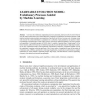Free Online Productivity Tools
i2Speak
i2Symbol
i2OCR
iTex2Img
iWeb2Print
iWeb2Shot
i2Type
iPdf2Split
iPdf2Merge
i2Bopomofo
i2Arabic
i2Style
i2Image
i2PDF
iLatex2Rtf
Sci2ools
123
click to vote
ML
2000
ACM
2000
ACM
Learnable Evolution Model: Evolutionary Processes Guided by Machine Learning
A new class of evolutionary computation processes is presented, called Learnable Evolution Model or LEM. In contrast to Darwinian-type evolution that relies on mutation, recombination, and selection operators, LEM employs machine learning to generate new populations. Specifically, in Machine Learning mode, a learning system seeks reasons why certain individuals in a population (or a collection of past populations) are superior to others in performing a designated class of tasks. These reasons, expressed as inductive hypotheses, are used to generate new populations. A remarkable property of LEM is that it is capable of quantum leaps ("insight jumps") of the fitness function, unlike Darwinian-type evolution that typically proceeds through numerous slight improvements. In our early experimental studies, LEM significantly outperformed evolutionary computation methods used in the experiments, sometimes achieving speed-ups of two or more orders of magnitude in terms of the number o...
Darwinian-type Evolution | Evolutionary Computation | Learnable Evolution Model | Machine Learning | ML 2000 |
Related Content
| Added | 19 Dec 2010 |
| Updated | 19 Dec 2010 |
| Type | Journal |
| Year | 2000 |
| Where | ML |
| Authors | Ryszard S. Michalski |
Comments (0)

